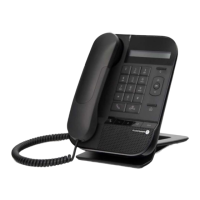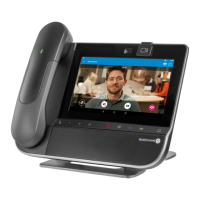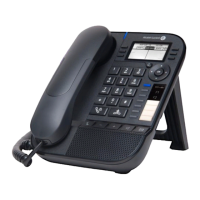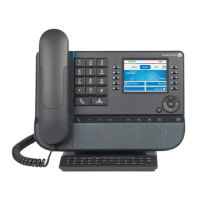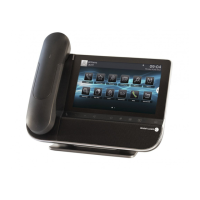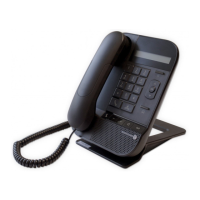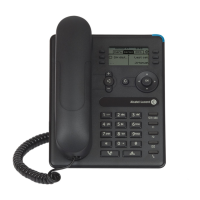Do you have a question about the Alcatel-Lucent OPENTOUCH ALE-500 and is the answer not in the manual?
Overview of the ALE-500 Enterprise DeskPhone features and capabilities.
Detailed description of the ALE-500 DeskPhone's physical components and interface.
Explanation of the virtual keyboard and virtual add-on module on the ALE-500.
Information on available ordering options and compatible accessories for the ALE-500.
Overview of the ALE-400 Enterprise DeskPhone features and capabilities.
Detailed description of the ALE-400 DeskPhone's physical components and interface.
Information on available ordering options and compatible accessories for the ALE-400.
Overview of the ALE-300 Enterprise DeskPhone features and capabilities.
Detailed description of the ALE-300 DeskPhone's physical components and interface.
Information on available ordering options and compatible accessories for the ALE-300.
Information on the removable keys for ALE-400 and ALE-300 models.
List of accessories compatible with the desk phones and available for order.
Guide to unpacking the desk phone and its components based on the model.
Explanation of the Smart Pad's keys, functions, and navigation interface.
Details on how to perform actions using short press, long press, and rotation gestures.
Information on the LED indicators on the Smart Pad and their meanings.
Guide to understanding LED status and management for different phone states.
Practical examples of how LED indicators function during calls and events.
Explanation of LED behavior during boot and software update phases.
Instructions on how to customize the phone's visual appearance by changing the theme.
Description of the phone's homepage structure and available pages like Menu, Perso, and Info.
Steps to select the default page displayed when the phone starts up.
Explanation of the main screen elements, customization area, and navigation key functions.
Overview of the call management screen, including tabs, notifications, and softkey actions.
Guide to accessing and using the user local menu for audio and display settings.
Settings for configuring Bluetooth devices, enabling features, and managing paired devices.
Option to change the phone's visual theme or skin.
Accessing software, hardware, and documentation details about the desk phone.
Accessing advanced desk phone configuration menus, often requiring administrator privileges.
Displaying regulatory information and compliance details for the desk phone.
Explanation of various status and call icons displayed on the phone's screen.
Description of the permanent and programmable feature keys on the desk phone and their functions.
Guide to using the alphanumeric keyboard for text input and dialing on specific phone models.
Detailed explanation of the different connectors available on the desk phone.
Instructions on how to connect the phone to power sources like adapter or PoE.
Information about the Power Boost feature for increased USB power delivery.
Explanation of how audio and signaling encryption works on the desk phone.
How to find the phone's identity number via the 'Info' page.
Guide to viewing and managing the phone's call history for incoming and outgoing calls.
Step-by-step instructions on how to initiate a phone call using different methods.
Methods for answering incoming calls using handset, headset, or hands-free mode.
How to ignore an incoming call and its consequences on phone ringing.
How to switch between different audio devices (handset, headset, speaker) during a call.
Instructions for activating the loudspeaker during a conversation for group listening.
How to search for contacts in the company directory and initiate calls by name.
Using programmed call keys (Perso, F1, F2, add-on) to quickly make calls.
How to redial the last dialed numbers or access the redial list.
Managing callback requests received via the messaging key.
Procedures for calling back the last caller or accessing the list of unanswered calls.
How to request an automatic callback when an internal number is busy.
Steps to cancel a previously requested automatic callback.
How to receive and answer interphony calls automatically in hands-free mode.
How to send DTMF signals for communication with voice servers or automated attendants.
Methods for muting the microphone during a call from the set or handset.
How to forward incoming calls directly to your voice mailbox.
Steps to access, listen to, and manage voice messages in your mailbox.
Instructions for composing and sending text messages to internal contacts.
How to read and manage incoming text messages on the desk phone.
Procedures for locking and unlocking the desk phone for security purposes.
How to place an active call on hold and retrieve it later on the same telephone.
Specific steps for placing a call on exclusive hold and retrieving it.
Using common hold to allow group members to resume a call put on hold by another.
How to place a call on hold and retrieve it from another telephone.
Steps to initiate a second call while already in a conversation.
How to answer an incoming second call while on an active conversation.
Managing multiple calls by switching between the active and held calls.
Methods for transferring an active call to another contact or number.
Steps to establish a conference call involving three or more participants.
How to transfer a conference call to leave two contacts talking together.
How to navigate and view information about participants in a conference call.
Adding multiple participants to an existing conference call.
Setting up and joining a conference call where participants dial in at a scheduled time.
Steps to start a 'Meet Me' conference call, including setting time and access code.
How to intrude into an ongoing internal call, with or without notification.
How to set up a call to prevent intrusion by other users.
How to signal a malicious call to the system for tracking or investigation.
Instructions for recording active conversations, with user rights and storage details.
Setting up immediate call forwarding to a specified number or destination.
Configuring call forwarding for missed calls or when the line is busy.
Activating and deactivating the Do Not Disturb feature to make the terminal unavailable.
Setting up call forwarding to receive calls at a different present location.
Forwarding calls based on specific criteria like immediate, busy, or no reply.
How to forward calls to a pager to enable contact while mobile.
Steps to deactivate all active call forwarding rules.
How to leave a text message that will be displayed on the calling terminal.
Configuring call routing for managers to assistants based on programmed keys.
How to answer calls ringing on another authorized user's extension.
How hunting groups function and how to manage group membership.
How to dial a contact's pager number when they do not answer directly.
How to respond to a pager alert from any telephone in the system.
Remotely activating a contact's phone loudspeaker if they do not answer.
How to broadcast a message to multiple terminals simultaneously.
Information on charging calls to business accounts and finding call costs.
Information specific to the agent's role and functions within the ACD system.
Steps for agents to log into the ACD system and start their session.
Description of the initial screen presented to agents upon logging into the ACD application.
Procedures for agents to log out of the ACD system and end their session.
Overview of the supervisor's role, rights, and capabilities within the ACD system.
Steps for supervisors to log into the ACD system.
Managing supervisor access and participation in processing groups within the ACD.
How supervisors can monitor calls, intrude, or provide assistance to agents.
Procedures for supervisors to log out of their session.
Guide to setting up the desk phone for remote access via VPN and secure connections.
Methods to access the desk phone's administration menu during boot or from the homepage.
Steps for the initial setup of the desk phone for remote working, including PIN code configuration.
How to modify VPN and other configuration parameters for remote working.
Details about PIN code composition, usage, and security for VPN configuration.
Instructions on how to reset the PIN code if it's forgotten or needs changing.
Steps to revert the desk phone from remote working mode back to the office network.
Steps to reconnect the desk phone to a remote location after being in the office.
How the desk phone can function as a beacon for enterprise geo-localization using Bluetooth.
Using the VNA feature for distributing audio messages or urgent notifications to groups.
Steps to initialize the voice mailbox, set a personal code, and record a name.
How to record and set a personalized voice greeting for your mailbox.
How to change the password for accessing phone programming functions and locking the set.
Changing the personal code used to access and manage voice messages.
Guide to adjusting audio settings like ringtones and ringer volume.
Selecting ringtones for internal and external calls from a list of available melodies.
Setting the ringer volume level for incoming calls, with options for silent mode.
Enabling or disabling silent mode for calls, with options for progressive or discreet ringing.
Configuring meeting mode or progressive ringing for calls.
Activating or deactivating discreet ring mode for incoming calls.
Adjusting the ringer volume during an incoming call.
Selecting different audio ambiences (Neutral, Bass Boost, Clarity, Legacy) for personalized sound.
Activating the hearing aid compatibility feature for users with hearing devices.
Guide to adjusting display, LED, and logo brightness settings.
Configuring automatic adjustment of display and LED brightness based on ambient light.
Setting the brightness level for the phone when it is idle or in screensaver mode.
Adjusting the display brightness level while the phone is actively being used.
Setting a specific dimmed brightness level for when the phone is idle.
Configuring the time delay before the screen brightness dims when the phone is not in use.
Choosing the default page that appears when the phone is powered on.
Setting the preferred language for the phone's interface and menus.
Customizing programmable keys like F1, F2, and softkeys for direct calls or functions.
Personalizing the appearance of programmable softkey labels with color and bold styles.
Changing the settings or assigned function of an existing programmed key.
Removing a programmed key and its assigned function from the phone.
Setting up temporary reminders for appointments directly on the desk phone.
Associating another set's number with your own for easier calling.
Setting up call forwarding rules to an associated number based on various conditions.
Changing the phone number or destination linked to the associated set feature.
Grouping multiple sets under a single number for simultaneous ringing and call handling.
Managing a list of up to 10 numbers for interphony calls.
Connecting and detecting USB audio accessories like headsets and loudspeakers.
Steps for pairing and connecting a Bluetooth headset to the desk phone.
Overview of connected devices and how to manage them.
Viewing a list of all connected audio devices and their connection types.
Selecting a preferred accessory as the default device when multiple similar devices are connected.
Instructions for using a paired Bluetooth headset for calls and other functions.
Viewing a list of all Bluetooth devices that have been paired with the desk phone.
Steps to remove a paired Bluetooth accessory from the desk phone's list.
Information on how to contact technical support and what details to provide.
Locating and identifying the phone's date code and technical codes for support.
How to check the current software version installed on the desk phone.
Finding the hardware model information for the desk phone.
Accessing online documentation and user manuals via QR code.
Accessing the Rainbow collaboration platform homepage via QR code.
Viewing the legal and regulatory information pertaining to the desk phone.
How administrators can access and modify the phone's configuration settings.
Instructions for updating the desk phone software using a USB key.
Guidance on preparing and sending the desk phone or add-on modules for hardware support.
How to copy diagnostic logs from the desk phone to a USB drive for troubleshooting.
An overview of the accessory categories and where to find more details.
Listing of available USB accessories such as headsets and keyboards.
Listing of available Bluetooth accessories like wireless modules and handsets.
Information on compatible third-party headsets certified through the DSPP program.
Listing of miscellaneous accessories including corded handsets, wall mounts, and customization kits.
Details and description of the ALE-160 Wireless Bluetooth Handset.
Physical description of the ALE-160 cordless handset, including key functions and components.
Contents of the ALE-160 cordless handset package and safety instructions.
Explanation of the LED colors and patterns on the ALE-160 handset indicating status.
Instructions for installing or replacing the battery in the ALE-160 Bluetooth handset.
Steps to enable and activate the Bluetooth feature on the desk phone for the handset.
Detailed guide on pairing and establishing a wireless connection between the handset and desk phone.
Simplified process for pairing the ALE-160 handset with the desk phone.
Standard procedure for pairing the ALE-160 handset, including searching and adding the device.
How to view connection status, MAC address, serial number, and battery level of the handset.
Guide to voice prompts for handset functions and available language settings.
Selecting the desired language for voice prompts on the ALE-160 handset.
Enabling or disabling voice prompt feedback for handset operations.
Switching between voice prompts and touch beep feedback for handset operations.
How to trigger the handset to ring for easy location.
Steps to disconnect and remove a paired Bluetooth handset from the desk phone.
Information on checking and performing software updates for the Bluetooth handset.
Details and description of the ALE-150 Super Wide Band Comfort Wired Handset.
Physical description of the ALE-150 corded handset and its components.
Contents of the ALE-150 corded handset package.
Instructions for connecting the ALE-150 corded handset to the desk phone.
Introduction to the ALE-100 USB magnetic keyboard for text input.
Description of the ALE-100 keyboard, including country variants and connection.
Contents of the ALE-100 keyboard package.
Instructions for connecting the ALE-100 keyboard to the desk phone via USB-C.
Guide to using the ALE-100 keyboard for text entry, special characters, and navigation.
Information about kits for changing the color of the desk phone.
Description of the ALE-140 customization kits and available colors.
Contents of the ALE-140 customization kit package.
Step-by-step guide on how to attach or detach the customization kit pieces.
Detailed instructions for removing the customization kit pieces from the desk phone.
Detailed instructions for installing the customization kit pieces onto the desk phone.
Introduction to the ALE-120 module that adds programmable keys to the desk phone.
Description of the ALE-120 module, its features, and navigation capabilities.
Contents of the ALE-120 key expansion module package.
Explanation of the USB-C connectors on the ALE-120 module and their uses.
General instructions for installing the ALE-120 module on the desk phone.
Step-by-step guide for physically attaching the ALE-120 module to the desk phone.
Guidance on connecting multiple add-on modules to a single desk phone, including power considerations.
Description of the Smart Pad navigation interface on the ALE-120 key expansion module.
Explanation of LED indicators on the ALE-120 module for incoming calls and events.
Reference to the section on programming keys for call numbers and functions.
Information about the kit for mounting the desk phone on a wall.
Step-by-step instructions for installing the ALE-110 wall mount kit.
Details about the wireless module for adding Bluetooth and Wi-Fi features.
Description of the ALE-108 module, its capabilities, and required applications.
Contents of the ALE-108 wireless module package.
Instructions for installing the ALE-108 wireless module into the desk phone.
Information on third-party headsets certified through the Developer and Solution Partner Program.
Critical safety precautions and guidelines for using the desk phones and related equipment.
Compliance statements and directives for EU countries regarding radio and EMC regulations.
Compliance information specific to Canadian regulations for RF devices.
Compliance information specific to US FCC rules for digital devices and RF exposure.
California-specific warnings regarding exposure to certain chemicals in the product.
Information on RF exposure limits and compliance for the desk phones.
Notes on local regulations and restrictions for using wireless LAN frequencies.
Specific regulatory compliance details for the ALE-160 cordless handset.
Specific regulatory compliance details for the ALE-108 wireless module.
Guidelines for the proper disposal of electronic equipment and batteries.
Information on where to find additional documentation and language versions.
Explanation of the different types of keys on the desk phone and their primary functions.
A quick reference for understanding various status indicators and call icons.
Overview of the ALE-500 Enterprise DeskPhone features and capabilities.
Detailed description of the ALE-500 DeskPhone's physical components and interface.
Explanation of the virtual keyboard and virtual add-on module on the ALE-500.
Information on available ordering options and compatible accessories for the ALE-500.
Overview of the ALE-400 Enterprise DeskPhone features and capabilities.
Detailed description of the ALE-400 DeskPhone's physical components and interface.
Information on available ordering options and compatible accessories for the ALE-400.
Overview of the ALE-300 Enterprise DeskPhone features and capabilities.
Detailed description of the ALE-300 DeskPhone's physical components and interface.
Information on available ordering options and compatible accessories for the ALE-300.
Information on the removable keys for ALE-400 and ALE-300 models.
List of accessories compatible with the desk phones and available for order.
Guide to unpacking the desk phone and its components based on the model.
Explanation of the Smart Pad's keys, functions, and navigation interface.
Details on how to perform actions using short press, long press, and rotation gestures.
Information on the LED indicators on the Smart Pad and their meanings.
Guide to understanding LED status and management for different phone states.
Practical examples of how LED indicators function during calls and events.
Explanation of LED behavior during boot and software update phases.
Instructions on how to customize the phone's visual appearance by changing the theme.
Description of the phone's homepage structure and available pages like Menu, Perso, and Info.
Steps to select the default page displayed when the phone starts up.
Explanation of the main screen elements, customization area, and navigation key functions.
Overview of the call management screen, including tabs, notifications, and softkey actions.
Guide to accessing and using the user local menu for audio and display settings.
Settings for configuring Bluetooth devices, enabling features, and managing paired devices.
Option to change the phone's visual theme or skin.
Accessing software, hardware, and documentation details about the desk phone.
Accessing advanced desk phone configuration menus, often requiring administrator privileges.
Displaying regulatory information and compliance details for the desk phone.
Explanation of various status and call icons displayed on the phone's screen.
Description of the permanent and programmable feature keys on the desk phone and their functions.
Guide to using the alphanumeric keyboard for text input and dialing on specific phone models.
Detailed explanation of the different connectors available on the desk phone.
Instructions on how to connect the phone to power sources like adapter or PoE.
Information about the Power Boost feature for increased USB power delivery.
Explanation of how audio and signaling encryption works on the desk phone.
How to find the phone's identity number via the 'Info' page.
Guide to viewing and managing the phone's call history for incoming and outgoing calls.
Step-by-step instructions on how to initiate a phone call using different methods.
Methods for answering incoming calls using handset, headset, or hands-free mode.
How to ignore an incoming call and its consequences on phone ringing.
How to switch between different audio devices (handset, headset, speaker) during a call.
Instructions for activating the loudspeaker during a conversation for group listening.
How to search for contacts in the company directory and initiate calls by name.
Using programmed call keys (Perso, F1, F2, add-on) to quickly make calls.
How to redial the last dialed numbers or access the redial list.
Managing callback requests received via the messaging key.
Procedures for calling back the last caller or accessing the list of unanswered calls.
How to request an automatic callback when an internal number is busy.
Steps to cancel a previously requested automatic callback.
How to receive and answer interphony calls automatically in hands-free mode.
How to send DTMF signals for communication with voice servers or automated attendants.
Methods for muting the microphone during a call from the set or handset.
How to forward incoming calls directly to your voice mailbox.
Steps to access, listen to, and manage voice messages in your mailbox.
Instructions for composing and sending text messages to internal contacts.
How to read and manage incoming text messages on the desk phone.
Procedures for locking and unlocking the desk phone for security purposes.
How to place an active call on hold and retrieve it later on the same telephone.
Specific steps for placing a call on exclusive hold and retrieving it.
Using common hold to allow group members to resume a call put on hold by another.
How to place a call on hold and retrieve it from another telephone.
Steps to initiate a second call while already in a conversation.
How to answer an incoming second call while on an active conversation.
Managing multiple calls by switching between the active and held calls.
Methods for transferring an active call to another contact or number.
Steps to establish a conference call involving three or more participants.
How to transfer a conference call to leave two contacts talking together.
How to navigate and view information about participants in a conference call.
Adding multiple participants to an existing conference call.
Setting up and joining a conference call where participants dial in at a scheduled time.
Steps to start a 'Meet Me' conference call, including setting time and access code.
How to intrude into an ongoing internal call, with or without notification.
How to set up a call to prevent intrusion by other users.
How to signal a malicious call to the system for tracking or investigation.
Instructions for recording active conversations, with user rights and storage details.
Setting up immediate call forwarding to a specified number or destination.
Configuring call forwarding for missed calls or when the line is busy.
Activating and deactivating the Do Not Disturb feature to make the terminal unavailable.
Setting up call forwarding to receive calls at a different present location.
Forwarding calls based on specific criteria like immediate, busy, or no reply.
How to forward calls to a pager to enable contact while mobile.
Steps to deactivate all active call forwarding rules.
How to leave a text message that will be displayed on the calling terminal.
Configuring call routing for managers to assistants based on programmed keys.
How to answer calls ringing on another authorized user's extension.
How hunting groups function and how to manage group membership.
How to dial a contact's pager number when they do not answer directly.
How to respond to a pager alert from any telephone in the system.
Remotely activating a contact's phone loudspeaker if they do not answer.
How to broadcast a message to multiple terminals simultaneously.
Information on charging calls to business accounts and finding call costs.
Information specific to the agent's role and functions within the ACD system.
Steps for agents to log into the ACD system and start their session.
Description of the initial screen presented to agents upon logging into the ACD application.
Procedures for agents to log out of the ACD system and end their session.
Overview of the supervisor's role, rights, and capabilities within the ACD system.
Steps for supervisors to log into the ACD system.
Managing supervisor access and participation in processing groups within the ACD.
How supervisors can monitor calls, intrude, or provide assistance to agents.
Procedures for supervisors to log out of their session.
Guide to setting up the desk phone for remote access via VPN and secure connections.
Methods to access the desk phone's administration menu during boot or from the homepage.
Steps for the initial setup of the desk phone for remote working, including PIN code configuration.
How to modify VPN and other configuration parameters for remote working.
Details about PIN code composition, usage, and security for VPN configuration.
Instructions on how to reset the PIN code if it's forgotten or needs changing.
Steps to revert the desk phone from remote working mode back to the office network.
Steps to reconnect the desk phone to a remote location after being in the office.
How the desk phone can function as a beacon for enterprise geo-localization using Bluetooth.
Using the VNA feature for distributing audio messages or urgent notifications to groups.
Steps to initialize the voice mailbox, set a personal code, and record a name.
How to record and set a personalized voice greeting for your mailbox.
How to change the password for accessing phone programming functions and locking the set.
Changing the personal code used to access and manage voice messages.
Guide to adjusting audio settings like ringtones and ringer volume.
Selecting ringtones for internal and external calls from a list of available melodies.
Setting the ringer volume level for incoming calls, with options for silent mode.
Enabling or disabling silent mode for calls, with options for progressive or discreet ringing.
Configuring meeting mode or progressive ringing for calls.
Activating or deactivating discreet ring mode for incoming calls.
Adjusting the ringer volume during an incoming call.
Selecting different audio ambiences (Neutral, Bass Boost, Clarity, Legacy) for personalized sound.
Activating the hearing aid compatibility feature for users with hearing devices.
Guide to adjusting display, LED, and logo brightness settings.
Configuring automatic adjustment of display and LED brightness based on ambient light.
Setting the brightness level for the phone when it is idle or in screensaver mode.
Adjusting the display brightness level while the phone is actively being used.
Setting a specific dimmed brightness level for when the phone is idle.
Configuring the time delay before the screen brightness dims when the phone is not in use.
Choosing the default page that appears when the phone is powered on.
Setting the preferred language for the phone's interface and menus.
Customizing programmable keys like F1, F2, and softkeys for direct calls or functions.
Personalizing the appearance of programmable softkey labels with color and bold styles.
Changing the settings or assigned function of an existing programmed key.
Removing a programmed key and its assigned function from the phone.
Setting up temporary reminders for appointments directly on the desk phone.
Associating another set's number with your own for easier calling.
Setting up call forwarding rules to an associated number based on various conditions.
Changing the phone number or destination linked to the associated set feature.
Grouping multiple sets under a single number for simultaneous ringing and call handling.
Managing a list of up to 10 numbers for interphony calls.
Connecting and detecting USB audio accessories like headsets and loudspeakers.
Steps for pairing and connecting a Bluetooth headset to the desk phone.
Overview of connected devices and how to manage them.
Viewing a list of all connected audio devices and their connection types.
Selecting a preferred accessory as the default device when multiple similar devices are connected.
Instructions for using a paired Bluetooth headset for calls and other functions.
Viewing a list of all Bluetooth devices that have been paired with the desk phone.
Steps to remove a paired Bluetooth accessory from the desk phone's list.
Information on how to contact technical support and what details to provide.
Locating and identifying the phone's date code and technical codes for support.
How to check the current software version installed on the desk phone.
Finding the hardware model information for the desk phone.
Accessing online documentation and user manuals via QR code.
Accessing the Rainbow collaboration platform homepage via QR code.
Viewing the legal and regulatory information pertaining to the desk phone.
How administrators can access and modify the phone's configuration settings.
Instructions for updating the desk phone software using a USB key.
Guidance on preparing and sending the desk phone or add-on modules for hardware support.
How to copy diagnostic logs from the desk phone to a USB drive for troubleshooting.
An overview of the accessory categories and where to find more details.
Listing of available USB accessories such as headsets and keyboards.
Listing of available Bluetooth accessories like wireless modules and handsets.
Information on compatible third-party headsets certified through the DSPP program.
Listing of miscellaneous accessories including corded handsets, wall mounts, and customization kits.
Details and description of the ALE-160 Wireless Bluetooth Handset.
Physical description of the ALE-160 cordless handset, including key functions and components.
Contents of the ALE-160 cordless handset package and safety instructions.
Explanation of the LED colors and patterns on the ALE-160 handset indicating status.
Instructions for installing or replacing the battery in the ALE-160 Bluetooth handset.
Steps to enable and activate the Bluetooth feature on the desk phone for the handset.
Detailed guide on pairing and establishing a wireless connection between the handset and desk phone.
Simplified process for pairing the ALE-160 handset with the desk phone.
Standard procedure for pairing the ALE-160 handset, including searching and adding the device.
How to view connection status, MAC address, serial number, and battery level of the handset.
Guide to voice prompts for handset functions and available language settings.
Selecting the desired language for voice prompts on the ALE-160 handset.
Enabling or disabling voice prompt feedback for handset operations.
Switching between voice prompts and touch beep feedback for handset operations.
How to trigger the handset to ring for easy location.
Steps to disconnect and remove a paired Bluetooth handset from the desk phone.
Information on checking and performing software updates for the Bluetooth handset.
Details and description of the ALE-150 Super Wide Band Comfort Wired Handset.
Physical description of the ALE-150 corded handset and its components.
Contents of the ALE-150 corded handset package.
Instructions for connecting the ALE-150 corded handset to the desk phone.
Introduction to the ALE-100 USB magnetic keyboard for text input.
Description of the ALE-100 keyboard, including country variants and connection.
Contents of the ALE-100 keyboard package.
Instructions for connecting the ALE-100 keyboard to the desk phone via USB-C.
Guide to using the ALE-100 keyboard for text entry, special characters, and navigation.
Information about kits for changing the color of the desk phone.
Description of the ALE-140 customization kits and available colors.
Contents of the ALE-140 customization kit package.
Step-by-step guide on how to attach or detach the customization kit pieces.
Detailed instructions for removing the customization kit pieces from the desk phone.
Detailed instructions for installing the customization kit pieces onto the desk phone.
Introduction to the ALE-120 module that adds programmable keys to the desk phone.
Description of the ALE-120 module, its features, and navigation capabilities.
Contents of the ALE-120 key expansion module package.
Explanation of the USB-C connectors on the ALE-120 module and their uses.
General instructions for installing the ALE-120 module on the desk phone.
Step-by-step guide for physically attaching the ALE-120 module to the desk phone.
Guidance on connecting multiple add-on modules to a single desk phone, including power considerations.
Description of the Smart Pad navigation interface on the ALE-120 key expansion module.
Explanation of LED indicators on the ALE-120 module for incoming calls and events.
Reference to the section on programming keys for call numbers and functions.
Information about the kit for mounting the desk phone on a wall.
Step-by-step instructions for installing the ALE-110 wall mount kit.
Details about the wireless module for adding Bluetooth and Wi-Fi features.
Description of the ALE-108 module, its capabilities, and required applications.
Contents of the ALE-108 wireless module package.
Instructions for installing the ALE-108 wireless module into the desk phone.
Information on third-party headsets certified through the Developer and Solution Partner Program.
Critical safety precautions and guidelines for using the desk phones and related equipment.
Compliance statements and directives for EU countries regarding radio and EMC regulations.
Compliance information specific to Canadian regulations for RF devices.
Compliance information specific to US FCC rules for digital devices and RF exposure.
California-specific warnings regarding exposure to certain chemicals in the product.
Information on RF exposure limits and compliance for the desk phones.
Notes on local regulations and restrictions for using wireless LAN frequencies.
Specific regulatory compliance details for the ALE-160 cordless handset.
Specific regulatory compliance details for the ALE-108 wireless module.
Guidelines for the proper disposal of electronic equipment and batteries.
Information on where to find additional documentation and language versions.
Explanation of the different types of keys on the desk phone and their primary functions.
A quick reference for understanding various status indicators and call icons.
| Type | IP Phone |
|---|---|
| Audio Quality | HD audio |
| Ethernet Ports | 2 |
| Network Interfaces | Ethernet |
| Power over Ethernet | 802.3af Power over Ethernet (PoE) |
| Supported Protocols | SIP |
| Audio | Wideband audio, hands-free speakerphone |
| Features | headset support |
| Model | OPENTOUCH ALE-500 |
| Display | Graphical display |
| Dimensions | 220 x 220 x 150 mm |


